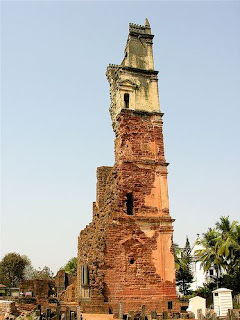St. Francis of Assisi Church
 |
| St. Francis of Assisi Church Goa, India |
To the west of the Se Cathedral is the former palace of the Archbishop that connects the Se Cathedral to the Convent and Church of St. Francis of Assisi. The structure is built of laterite blocks and is lime-plastered.
The church faces west and has a nave with three chapels on either side, a choir, two altars in the transept and a main altar. To the north of the main altar is a belfry and a sacristy. The convent, which forms an annexure to the church, now houses the Archaeological Museum.
The exterior of the Church is of the Tuscan Order while the main entrance is in Manuline style. The main altar is Baroque with Corinthian features. There are no aisles but only a nave, which is rib-vaulted.
The internal buttress walls, separating the chapels and supporting the gallery on top, have frescoes showing intricate floral designs.
The church faces west and has a nave with three chapels on either side, a choir, two altars in the transept and a main altar. To the north of the main altar is a belfry and a sacristy. The convent, which forms an annexure to the church, now houses the Archaeological Museum.
The exterior of the Church is of the Tuscan Order while the main entrance is in Manuline style. The main altar is Baroque with Corinthian features. There are no aisles but only a nave, which is rib-vaulted.
The internal buttress walls, separating the chapels and supporting the gallery on top, have frescoes showing intricate floral designs.
 |
| St. Francis of Assisi Church |
In a niche on the façade, stands a statue of our lady of miracles brought from Jaffna in Sri Lanka. A wooden statue of St. Francis of Assisi adorns a pedestal bearing the insignia of the Franciscans. A wooden pulpit, richly carved with floral designs is to the left as one enters.
Beneath a ribbed vault with frescoes showing floral decorations, is the main altar, which is gilded and has a richly carved niche with a tabernacle supported by the four evangelists.
The tabernacle was used for displaying the holy sacrament. Above the tabernacle, in the main altar, is a large statue of St. Francis of Assisi and an equally large statue of Jesus on the cross. Beneath the two figures are inscribed the three vows of the Saint - poverty, humility and obedience. On either side of the main altar, in the nave, are beautiful large paintings on wood, depicting scenes from the life of St. Francis of Assai.
Beneath a ribbed vault with frescoes showing floral decorations, is the main altar, which is gilded and has a richly carved niche with a tabernacle supported by the four evangelists.
The tabernacle was used for displaying the holy sacrament. Above the tabernacle, in the main altar, is a large statue of St. Francis of Assisi and an equally large statue of Jesus on the cross. Beneath the two figures are inscribed the three vows of the Saint - poverty, humility and obedience. On either side of the main altar, in the nave, are beautiful large paintings on wood, depicting scenes from the life of St. Francis of Assai.
 |
| St. Francis of Assisi Church |
The origin of this church and the attached convent can be traced to the humble beginnings made by eight Franciscan friars, who, on their arrival in 1517, secured from the then Governor a few houses that belonged to a deceased Thanadar. By their persistent efforts they constructed a small chapel with three altars and a choir.
A church consecrated to the Holy Ghost was built in 1521 and was later pulled down and the present church was built on the same spot in 1661 retaining only the entrance of the earlier church.
A church consecrated to the Holy Ghost was built in 1521 and was later pulled down and the present church was built on the same spot in 1661 retaining only the entrance of the earlier church.
Where to stay :
The Kenilworth Beach Resort & Spa
Utorda , Salcete
08326698888
08322754183
kenilworthgoa@kenilworthhotels.com
Heritage Village Club
Arossim Beach, Arossim
Cansaulim , Goa
08326694444
08322754324
goa@sresorts.com
Utorda , Salcete
08326698888
08322754183
kenilworthgoa@kenilworthhotels.com
Heritage Village Club
Arossim Beach, Arossim
Cansaulim , Goa
08326694444
08322754324
goa@sresorts.com
How to reach St. Francis of Assisi Church
AIR
Dabolim airport of Goa is well connected by flight with major cities in India.
RAIL
Madgaon, Vasco-da-Gama, Tivim and Karmali railway stations of Goa are well connected by trains with major cities and places in India.
ROAD
Panaji, Mapusa, Margao, and other main cities of Goa are well connected by motorable roads with different cities and places in India.
Tourism Office Details :
Department of Tourism
Government of Goa
Purshottam Bhagwan Building
Dr. Atmaram Borkar Road, Opp. Hotel Nova Goa,
Panaji, Goa- 403 001
Tel: 0832 - 2438750/51/52
Email: goatourism @ dataone.in
(a) Branch Office-North Tourist Shopping Complex, Mapusa. Tel: 2262390
(b) Branch Office - South, Margao Residency, Margao. Tel. 2715204
(c) Tourist Information Counter, Interstate Bus Terminus, Panaji.
(d) Tourist Information Counter, Vasco Residency, Vasco-da-Gama. Tel. 2512673
(e) Tourist Information Counter, Goa Airport, Dabolim Tel. 2541644/2542476
(f) Tourist Information Counter, Railway Station, Margao. Tel: 2702298.
Goa Tourism Development Corporation Ltd.
Trionora Apartments,
Dr. Alvares Costa Road,
Panaji.
Tel. 2226515, 2224132, 2226728.
Fax: 091-832-2423926;
Central Reservation Office
Tel Nos. 091-832-2424001-3, 2436666,
E-mail: reservations@goa-tourism.com
Website : www.goa-tourism.com
Facilitation counter at Goa Airport, Dabolim, Tel: 091-832-2540829/2540031













